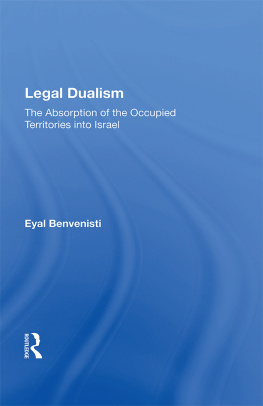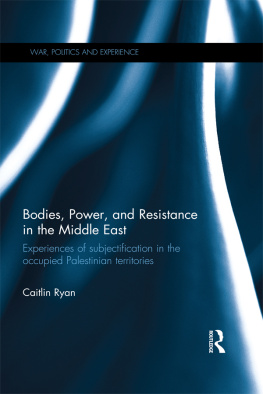Legal Dualism
The Absorption of the Occupied Territories into Israel
The West Bank Data Base Project
The West Bank Data Base Project is an independent research group established in 1982 to study and analyze demographic, social, spatial, legal, economic, and political conditions in the West Bank and Gaza. The project, which is directed by Dr. Meron Benvenisti, is funded by the Rockefeller and Ford foundations and administered by the Brookings Institution, Washington, D.C. A continuously updated, computerized data base and its own research are the basis for the Projects publications, including maps showing present and projected developments in the region.
About the Author
Eyal Benvenisti is a graduate of the Hebrew University and received his doctorate from the Yale Law School. Dr. Benvenisti teaches at the Hebrew University, Jerusalem.
First published 1990 by Westview Press
Published 2018 by Routledge
52 Vanderbilt Avenue, New York, NY 10017
2 Park Square, Milton Park, Abingdon, Oxon OX14 4RN
Routledge is an imprint of the Taylor & Francis Group, an informa business
Copyright 1990 by Eyal Benvenisti and The West Bank Data Base Project
All rights reserved. No part of this book may be reprinted or reproduced or utilised in any form or by any electronic, mechanical, or other means, now known or hereafter invented, including photocopying and recording, or in any information storage or retrieval system, without permission in writing from the publishers.
Notice:
Product or corporate names may be trademarks or registered trademarks, and are used only for identification and explanation without intent to infringe.
Library of Congress Cataloging-in-Publication Data
Benvenisti, Eyal.
Legal dualism: the absorption of the occupied territories into
Israel / by Eyal Benvenisti.
p. cm.
The West Bank Data Base ProjectCIP verso t.p.
ISBN 0-8133-7983-0
1. LawWest Bank. 2. Martial lawWest Bank. 3. LawGaza
Strip. 4. Martial lawGaza Strip. 5. Israel-Arab War, 1967
Occupied territories. I. West Bank Data Base Project. II. Title.
LAW
342.56953062dc20
[345.695302262]
90-12239
CIP
ISBN 13: 978-0-367-01566-4 (hbk)
Acknowledgements
This survey is part of my preparatory research for a doctoral dissertation to be submitted to the Yale Law School. I am indebted to Professor W. Michael Reisman for his most useful ideas and criticisms of this work, no less than for his encouragement along the road. My father, Meron Benvenisti, assisted me in obtaining the various military orders and also commented on the outcome. Hillel Sommer read the manuscript and offered many valuable suggestions.
I am very grateful to the Yale Law School for the considerable support it has provided during my stay in New Haven. A grant from the Lucius N. Littauer Foundation also helped to make the research possible.
E.B.
July 1989
This paper examines the various methods by which Israeli law is being applied to the occupied territories and their inhabitants. Whether through extensive lawmaking by the military authorities, through extraterritorial prescription of Israeli laws, or through caselaw of the Israeli courts, large segments of the law of the territories have become Israeli law. This is an outcome of a lengthy step-by-step process. Nothing was effected overnight. All the moves that were taken were claimed to be in accordance with the framework of the belligerent occupation under international law, more specifically, with the 1907 Hague Regulations Respecting the Laws and Customs of War on Land. Although Israel has never formally recognized that its status in the territories is that of a belligerent occupant, it still justifies its acts there by resorting to the framework prescribed by international law.
If the test for annexation is the application of the whole body of laws to another territory, coupled with an indication of the intention to permanently retain it, then the legal absorption of the territories does not amount to annexation. Not all the Israeli laws have been applied there, and the military government is still formally responsible for the territories. In the wake of the Palestinian uprising, and King Husseins renunciation of Jordanian claims to the West Bank, voices in the political community in Israel have been urging the annexation of Judea and Samaria (the biblical names for the West Bank and Gaza). But no such decision has been taken. One conclusion from my survey is that Israel does not need it. As this paper will show, the pre-June 1967 borders have faded for almost all legal purposes that reflect Israeli interests. However, with regard to the interests of the local population, especially those concerning civil rights, those borders still exist. The veil of military government provides a convenient legal tool to explain the unequal treatment of communities.
In this paper I report on the legal situation of the territories from the point of view of the positive law that is in effect there. I will not deal with aspects of international law. My aim is to establish a factual account of the Israeli experience of occupation. With regard to the nature of international law of belligerent occupation, the president of the Israeli Supreme Court, Justice Meir Shamgar, once commented:
Within the dualistic framework of the legal data and the political data two separate elements which are too often tangential and even overlap there is conspicuous interaction which directly influences the fashioning and interpretation of rules of international law. It fosters subjective outlooks and at times contributes to the still existing lack of unanimity and clarity which is one of the characteristics of some of the rules we are dealing with. In relation to the factual data, actual and apparent, persuasive answers are most difficult to arrive at because international society lacks impartial fact-finding procedures; in relation to the legal problems, there is far too often little prospect of reaching an authoritative interpretation of the international legal status or of the relative legal rights and duties of the parties concerned.
The Israeli law prescription with regard to the territories is documented; therefore material disputes about facts are unlikely in this context. It is hoped that this paper will serve as a basis for a discussion concerning the legality of the situation under international law.
The first topic concerns the territorial law of the Jewish settlements in the territories. The reason I chose to begin with this issue is that the lands allocated to those settlements are excluded for almost all legal purposes from the rest of the territories under military rule. The second chapter deals with the personal law of the Israelis in the territories (inside and outside of the jurisdiction of the settlements), and examines how the Arab residents are affected by it. The third chapter examines the Israeli laws that apply to the Arab population and assesses the contribution of the Israeli High Court of Justice in this area. But before we begin, a short introduction to the lawmaking process of the military government is required.
1.
Introduction to Security Enactments: Lawmaking by the Military Government
The legal system of the territories is composed of two tiers.
The first one comprises military legislation, called security enactments. It subordinates the second tier, which includes the laws that were in force in the region before the beginning of the occupation. The Order Concerning Interpretation









